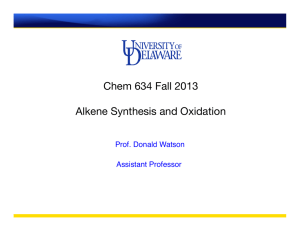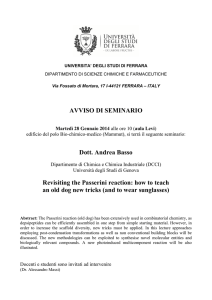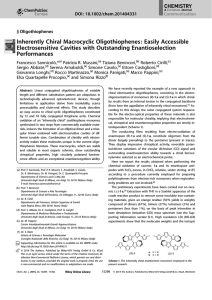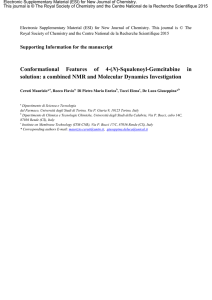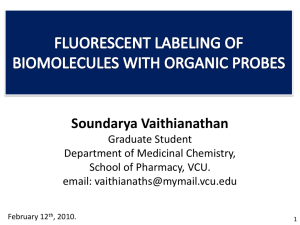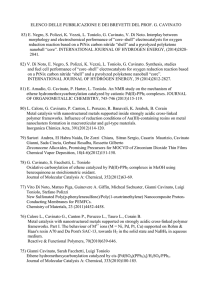the presentation here
advertisement
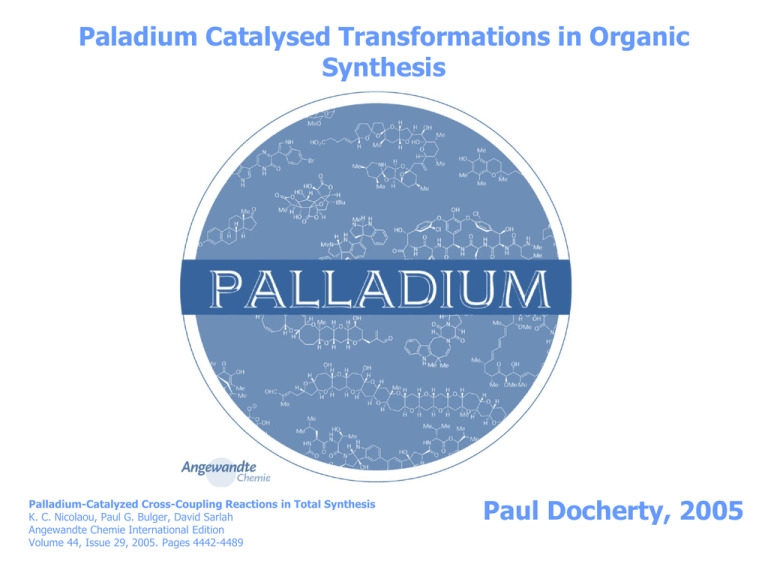
Paladium Catalysed Transformations in Organic
Synthesis
Palladium-Catalyzed Cross-Coupling Reactions in Total Synthesis
K. C. Nicolaou, Paul G. Bulger, David Sarlah
Angewandte Chemie International Edition
Volume 44, Issue 29, 2005. Pages 4442-4489
Paul Docherty, 2005
Introduction
•
Since Mizoroki[1] developed the first palladium catalysed reaction, research in this area has
developed exponentially, with each new issue of Angewandte Chemie or JACS highlighting the
latest techniques and processes.
•
These reactions show a breadth of applications, not just in the type of transformation, but in the
target structure and scale of the process. Indeed, it is common to see the retrosynthesis of
industrial targets hinge upon a crucial palladium-mediated reaction.
Pd
1.
T. Mizoroki, K. Mori, A. Ozaki, Bull. Chem. Soc. Jpn. 1971, 44, 581
(There is still some debate as to which coupling was developed first; many claim that the Kumada coupling of sp 2 grignard reagents
with aryl, vinyl or alkyl halides was the first. However, the intrinsic reactivity of grignard reagents with other common functionalities
mean that this coupling is seldom used.)
Why Palladium?
•
•
Why is palladium such an adept catalyst centre? Why not sodium?
The reason seems to be based around its electronegativity, which leads to relatively strong Pd-H
and Pd-C bonds, and also develops a polarised Pd-X bond.
It allows easy access to the Pd (II) and Pd (0) oxidation states, essential for processes such as
oxidative addition, transmetalation and reductive elimination,
Pd (I), Pd (III) and Pd (IV)[2] complexes are also known, though less thoroughly, with Pd (IV)
species essential in C-H activation mechanisms.
•
•
2.
Pd (VI) complexes has also been proposed (W. Chen, S. Shimada, M. Tanaka, Science, 2002, 295, 308), but theoretical articles
counter-argue this (E. C. Sherer, C. R. Kinsinger, B. L. Kormos, J.D. Thompson, C. J. Cramer Angew. Chem., Int. Ed. 2002, 41, 1953).
The debate is ongoing.
The Heck Reaction
•
Broadly defined as the palladium-catalyzed coupling of alkenyl or aryl
(sp2) halides or triflates with alkenes to yield products which formally
result from the substitution of a hydrogen atom in the alkene coupling
partner.
First discovered by Mizoroki, though developed and applied more
thoroughly by Richard F. Heck in the early 1970s.[3]
Generally thought of as the original palladium catalysed crosscoupling, and probably the best evolved, including a multitude of
asymmetric varients.[4]
•
•
R3
H
R4 X
R2
R1
cat. [Pd0Ln]
base
4
R = aryl, benzyl, vinyl
X = Cl, Br, I, OTf
R3
R4
R2
R1
3.
R. F. Heck, J. P. Nolley, Jr., J. Org. Chem. 1972, 37, 2320
4.
Review on asymmetric Heck reactions: A. B. Dounay, L. E. Overman, Chem. Rev. 2003, 103, 2945 – 2963
Mechanism of the Heck Reaction
neutral
O
-hydride
Elimination
O
O
PdII
O
Ph3P
Ph3P
H
B
Ph3P
Pd
Br
Pd
Br
H
PPh3
PPh3
Pd -Complex
PPh3
HBr / B
Reductive
Elimination
II
Pd
Ph3P
Pd0
PPh3
- PPh3
PdII -Intermediate
O
Ph3P
Br
O
Ph3P
Ph3P
Pd
- PPh3
PPh3
Pd
Pd0
PPh3 H H
Oxidative
Addition
PdII
O
O
Ph3P
Ph3P
Br
Br
Pd
PPh3
O
II
Pd -Complex
O
Pd
PPh3
Br
Ph3P
Pd0
Pd
PPh3
Mechanism of the Heck Reaction
cationic
O
-hydride
Elimination
O
O
PdII
O
Ph3P
Ph3P
H
PPh3
Pd
Pd
Ph3P
PPh3
- PPh3
O
Ph3P
Pd
Ph3P
Pd
- PPh3
PPh3
PPh3 H H
Pd0
Oxidative
Addition
PdII -Intermediate
PdII
BrAg
O
O
Ph3P
Ph3P
Pd
Br
Pd
PPh3
PdII -Complex
O
Ag
O
Abelman, M. M.; Oh, T.; Overman, L. E. J. Org. Chem. 1987, 52, 4133–4135.
PPh3
Pd0
PPh3
HB
Reductive
Elimination
PdII -Complex
Ph3P
Ph3P
Pd
PPh3
O
B
H
Br
Ph3P
Pd0
Pd
PPh3
Regioselectivity in the Heck Reaction
•
•
•
•
The type of mechanism in action is incredibly important, as it can manifest itself in a variety of
ways, especially the regioselectivity.
In the neutral catalytic cycle, the regioselectivity is governed by steric factors – generally addition
occurs to the terminal end of the alkene.
However, in the cationic cycle, regiochemistry is affected by electronics. The cationic Pd complex
increases the polarization of the alkene favouring transfer of the vinyl or aryl group to the site of
least electron density.
The type of mechanism in effect is generally controlled by choice of halide/pseudohalide acting as
a leaving group in the cationic cycle; triflate promotes, whereas bromide detracts.
Neutral Catalytic Cycle
Cationic Catalytic Cycle
10
CH3
Ph
100
40
90
OH
100
40
95
CH3
Ph
60
100
20
100
90
O
N
60
OH
5
O
Y
100
OH
80
Y = CO2R
CN
CONH2
Y
100
Y = CO2R
CN
CONH2
a) Cabri, W.; Candiani, I. Acc. Chem. Res. 1995, 28, 2–7.
b) Cabri, W.; Candiani, I.; Bedeschi, A.; Penco, S.; Santi, R. J. Org. Chem. 1992, 57, 1481–1486.
N
OH
10
The Heck Reaction: Dehydrotubifoline
dehydrotubifoline
Me
N H I
N
Pd(OAc)2, K2CO3
Me
3: (±)-dehydrotubifoline
N
H
R
1: R=H
2: R=CO2Me
H
N
MeO
H PdIIL
n
O
4
H
N
Heck Cyclisation
N
Me
H
nBu4NCl, DMF, 60 °C
N
second 1,2insertion
N
MeO2C
N
N
H
H
Me
H
Me
PdIILn
H
N
H
MeO2C
N
H
MeO2C
5
6
bond rotation,
rearrangement
a) V. H. Rawal, C. Michoud, R. F. Monestel, J. Am. Chem. Soc. 1993, 115, 3030 – 3031
b) V. H. Rawal, C. Michoud, J. Org. Chem. 1993, 58, 5583 – 5584.
PdIILn
H
7
-hydride
elimination
The Heck Reaction: Capnellene
TfO
catalysic
asymmetric
Heck Cyclisation
*
P
Pd
*
H
major
P
15
16
(89% yield,
80% ee)
OTf
P
Me
H
AcO
Me
OAc
P Pd
14 Me
anion
capture
Pd(OAc)2 (1.7 mol%)
(S)-binap (2.1 mol%)
nBu4NOAc
DMSO, 20 °C
OTf
Me
P
Pd
minor
18
capnellene
Me HHO
Me
OAc
OH
H
HO Me
9(12)-capnellene3,8,10-triol
Me
17
H
19
Me HHO
P
*
PPh2
PPh2
=
P
(S)-binap
*
P
OH
HO
H
HO Me
9(12)-capnellene3,8,10,14-tetraol
a) K. Kagechika, M. Shibasaki, J. Org. Chem. 1991, 56, 4093 –4094
b) K. Kagechika, T. Ohshima, M. Shibasaki, Tetrahedron, 1993, 49, 1773 – 1782.
Me
OAc
The Heck Reaction: Taxol
OTf
Me
O
O
[Pd(PPh3)4] (110 mol%)
M. S. (4 A)
K2CO3, MeCN, 90 °C
OTBS
Me
Intramolecular
Heck Reaction
O
H
O BnO
(49%)
OTBS
Me
22
Me
taxol
O
O
AcO
Ph
Me
O
BzHN
O
OH
H
O BnO
O
23
O
OH
Me
HO
H
BzO AcO
O
24: taxol
a) S. J. Danishefsky, J. J. Masters, W. B. Young, J. T. Link, L. B. Snyder, T. V. Magee, D. K. Jung, R. C. A. Isaacs, W. G. Bornmann, C. A.
Alaimo, C. A. Coburn, M. J. Di Grandi, J. Am. Chem. Soc. 1996, 118, 2843 – 2859
b) J. J. Masters, J. T. Link, L. B. Snyder, W. B. Young, S. J. Danishefsky, Angew. Chem. Int. Ed. Engl. 1995, 34, 1723 – 1726.
The Heck Reaction: Estrone
Br
MeO
25
t
Me O Bu
Me
Br
Pd(OAc)2, PPh3
nBu4NOAc
DMF/MeCN/H2O
70 °C
Intermolecular
Heck Reaction
OtBu
t
Me O Bu
5
4
Br
MeO
H
26
Br
(50%)
Br
PdLn
H
H
MeO
28
27
26
29, nBu4NOAc
DMF/MeCN/H2O
115 °C
(99%)
Me
o-Tol o-Tol
O P
Pd
O
O
Pd
P O
o-Tol o-Tol
Intramolecular
Heck Reaction
estrone
t
Me O Bu
Me O
Me
D
H
A
HO
H
H
30: estrone
L. F. Tietze, T. NVbel, M. Spescha, J. Am. Chem. Soc. 1998, 120, 8971 – 8977.
H
H
MeO
H
30
Domino Heck Reactions
Me
EtO2C
EtO2C
I
32
[Pd(PPh3)4] (3 mol%)
Et3N (2 eq.)
MeCN, 85 °C
(76%)
Intramolecular
Domino Heck
Cyclisation
Me
EtO2C
EtO2C
I
Y. Zhang, G.Wu, G. Angel, E. Negishi, J. Am. Chem. Soc. 1990, 112, 8590 – 8592.
Me
EtO2C
EtO2C
33
Domino Heck Reactions
Pd(OAc)2 (10 mol%)
PPh3 (20 mol%)
Ag2CO3
THF, 70 °C
O
O
I
O
O
O
PdLn
TBSO
38
Me
PdLn
H I
1,2-insertion
H
TBSO
37
Me
I
Oxidative
Addition
H
O
TBSO
39
Me
Intramolecular Heck Cascade
O
O
Me
1,2-insertion
H
O
Ln
Pd
I
O
Me
(82% overall)
-Hydride
Elimination
TBSO 40
H
Ln
Pd
I
scopadulic acid
Me
TBSO
41
O
Me
H
HO2C
HO
H
OBz
42: Scopadulic Acid B
a) L. E. Overman, D. J. Ricca, V. D. Tran, J. Am. Chem. Soc. 1993, 115, 2042 – 2044
b) D. J. Kucera, S. J. OIConnor, L. E. Overman, J. Org. Chem. 1993, 58, 5304 – 5306.
The Stille Coupling
Originally discovered by Kosugi et al[5] in the late 1970s, the Stille Coupling was later developed
as a tool for organic transformations by the late Professor J. K. Stille.[6]
Milder than the older Heck reaction, and more functional-group tolerant, the Stille coupling
remains popular in organic synthesis.
•
•
R1 SnR3
R2 X
cat. [Pd0Ln]
base
R1 R3
R1 = alkyl, alkynyl, aryl, vinyl
R2 = acyl, alkynyl, allyl, aryl, benzyl, vinyl
X = Br, Cl, I, OAc, OP(=O)(OR)2, OTf
•
A close relative of the Stille coupling is the Hiyama; this involves the palladium catalysed reaction
of a organosilicon with organic halides/triflates et c., but requires activation with fluoride (TBAF)
or hydroxide.[7]
It is possible to couple bis-aryl halides using R3Sn-SnR3, in a varient known as a Stille-Kelly
reaction, but the toxicity of these species is a somewhat limiting factor.[8]
•
5.
Original Report; a) M. Kosugi, K. Sasazawa, Y. Shimizu, T. Migita, Chem. Lett. 1977, 301 – 302; b) M. Kosugi, K. Sasazawa, T. Migita,
Chem. Lett. 1977, 1423 – 1424.
6.
a) D. Milstein, J. K. Stille, J. Am. Chem. Soc. 1978, 100, 3636 – 3638; b) D. Milstein, J. K. Stille, J. Am. Chem. Soc. 1979, 101, 4992 –
4998; c) For a review of Stille Reactions, see; V. Farina, V. Krishnamurthy,W. J. Scott, Org. React. 1997, 50, 1 – 652
7.
T. Hiyama, Y. Hatanaka, Pure Appl. Chem. 1994, 66, 1471
8.
T. R. Kelly, Tetrahedron Lett. 1990, 31, 161
Mechanism of the Stille Coupling
R2
Ph3P
Pd
Ph3P
PdII R1
Ph3P
Pd
R1
R2
R3
R1
R1
1
R
PPh3
Pd
Ph3P
Pd
- PPh3
Pd0
BrSnBu3
Pd
Br
Pd
R1
R2
SnBu3
R3
II
PPh3
PPh3
- PPh3
Ph3P
II
Pd
Ph3P
R2
Ph3P
Ph3P
Ph3P
Pd0
PPh3
Br
Ph3P
Pd0
Pd
PPh3
The Stille Coupling: Rapamycin
Me
O
O
H
OH
OMe O
Me
SnnBu3
N
O
O
H
OH
Me
O
Me
OMe Me
H
OH
OMe O
Bu3Sn
[PdCl2(MeCN)2]
(20 mol%) Me
OMe i
Pr2NEt, DMF,
THF, 25°C
OH
Intermolecular
Stille Coupling
Me
72
O
O
Me
n
H
O
I
I
Me
Me
I
SnnBu3
Intramolecular
Stille Coupling
N
H
O
O
O
OMe
OH
O
Me
H
OMe Me
Me
27%
Overall
OH
Me
74
"Stitching Cyclisation"
rapamycin
Me
O
H TESO
OMe O
Me
Me
O
N
Me
1. [PdCl2(MeCN)2] (20 mol%)
Pr2NEt, DMF, THF, 25°C (74%)
Sn Bu3
OTBS
H
O
Me
OMe Me
Me
75
H
OH
OMe O
Me
OMe
Intramolecular
Stille Coupling
N
H
O
2. Deprotection (61%)
O
n
O
Me
i
H
O
I
O
O
O
Me
H
O
OH
OTIPS
O
Me
OMe Me
Me
OMe
OH
Me
76: Rapamycin
a) K. C. Nicolaou, T. K. Chakraborty, A. D. Piscopio, N. Minowa, P. Bertinato, J. Am. Chem. Soc. 1993, 115, 4419 – 4420; K. C. Nicolaou, A. D.
Piscopio, P. Bertinato, T. K. Chakraborty, , N. Minowa, K. Koide, Chem. Eur. J. 1995, 1, 318 –333.
b) A. B. Smith III, S. M. Condon, J. A. McCauley, J. L. Leazer, Jr.,J. W. Leahy, R. E. Maleczka, Jr., J. Am. Chem. Soc. 1995, 117, 5407 – 5408.
The Stille Coupling: Dynamycin
dynemicin
I
I
Me3Sn
Me
TeocN
OH
O
OH
H
OTBS
SnMe3
[Pd(PPh3)4] (5 mol%)
DMF, 75 °C
81%
Tandem
Intermolecular
Stille Coupling
77
Me
TeocN
Me
OH
O
OH O
HN
CO2H
O
OH
OMe
H
OTBS
H
OH O
79
OH
81: (±) Dynamycin
Teoc = 2-(trimethylsilyl)ethoxycarbonyl
a) M. D. Shair, T.-Y. Yoon, K. K. Mosny, T. C. Chou, S. J. Danishefsky, J. Am. Chem. Soc. 1996, 118, 9509 – 9525;
b) M. D. Shair, T.-Y. Yoon, S. J. Danishefsky, Angew. Chem. 1995, 107, 1883 – 1885; Angew. Chem. Int. Ed. Engl. 1995, 34, 1721 – 1723;
c) M. D. Shair, T. Yoon, S. J. Danishefsky, J. Org. Chem. 1994, 59, 3755 – 3757.
23 I
The Stille Coupling: Sanglifehrin
SnnBu3
Me
Me
O
I
22
O
O
Me
NH O O HN
N
O
NH
Me
Me
Me
[Pd2(dba)3]•CHCl3
AsPh3, iPr2NEt
DMF, 25 °C, 62%
O
O
I
Chemoselective
Intramolecular
Stille macrocyclisation
O
O
Me
O
Me
NH O O HN
N
O
NH
Me
Me
OH
1. [Pd2(dba)3]•CHCl3
AsPh3, iPr2NEt
DMF, 40°C, 45%
OH
86
87
Intermolecular
Stille Coupling
2. aq. H2SO4
THF/H2O
(33%)
sanglifehrin
Me
Me
Me
Me
Me
O
Me
Me
Me
Me
Me
Me
O
OH
NH
O
OH
NH
O
SnnBu3
O
Me
Me
88
O
O
Me
Me
O
NH O O HN
N
O
NH
Me
Me
OH
87: sanglifehrin A
a) K. C. Nicolaou, J. Xu, F. Murphy, S. Barluenga, O. Baudoin, H.-X.Wei, D. L. F. Gray, T. Ohshima, Angew. Chem. Int. Ed. 1999, 38, 2447 –
2451;
b) K. C. Nicolaou, F. Murphy, S. Barluenga, T. Ohshima, H. Wei, J. Xu, D. L. F. Gray, O. Baudoin, J. Am. Chem. Soc. 2000, 122, 3830 – 3838.
The Stille Coupling: Manzamine A
Br
CO2Me
CO2Me
SnnBu3
[Pd(PPh3)4)] (4 mol%)
toluene, 120 °C
O
N
NBoc
NBoc
110
H
endo-intramolecular
TBDPSO
OTBDPS
TBDPSO
109
(68% Overall)
H N
Boc E
N
Intermolecular
Stille Coupling
Diels-Alder Reaction
N
O
OTBDPS
TBDPSO
OTBDPS O
manzamine
CO2Me
N
H
H
N
O
NBoc
N
A
N
H
B
OH
H
OTBDPS
OTBDPS
111
H
CN
D
112: Manzamine A
a) S. F. Martin, J. M. Humphrey, A. Ali, M. C. Hillier, J. Am. Chem. Soc. 1999, 121, 866 – 867;
b) J. M. Humphrey, Y. Liao, A. Ali, T. Rein, Y.-L. Wong, H.-J. Chen, A. K. Courtney, S. F. Martin, J. Am. Chem. Soc. 2002, 124, 8584 – 8592.
The Carbonylative Stille Coupling:
Jatrophone
O
Me
Me
Me
Me
O
OTf
SnnBu3
Me
[PdCl2(MeCN)2]
LiCl, CO (50 psi)
DMF, 25 °C
O
Me
Me
Intermolecular
Carbonylative
Stille Coupling
Me
PdLn
Cl
82
SnnBu3
83
Carbonyl
Insertion
jatrophone
O
Me
Me
O
O
Me
Me
Me
Me
Me
Me
O
Me
53% Overall
O
85: (±)-2-epi-jatrophone
A. C. Gyorkos, J. K. Stille, L. S. Hegedus, J. Am. Chem. Soc. 1990, 112, 8465 – 8472.
O
Me
Cl
PdLn
O
84
Me
Me
SnnBu3
The Suzuki Coupling
•
The Suzuki reaction was formally developed by Suzuki Group in
1979[9], although the inspiration for this work can be traced back
to publications by Heck[10] and Negishi,[11] and their earlier
presentation of these papers at conferences.
The popularity of this reaction can be partially attributed to the
ease of preparation of the organoboron reagents required, their
general stability, and the lack of toxic by-products.
Progress in the last quarter-century has shown that the Suzuki
reaction is incredibly powerful, with examples of C(sp2)–C(sp3)
and even C(sp3)–C(sp3) now well documented.[12]
•
•
R1 BY2
R2 X
cat. [Pd0Ln]
base
R1 R2
R1 = alkyl, alkynyl, aryl, vinyl
R2 = alkyl, alkynyl, aryl, benzyl, vinyl
X = Br, Cl, I, OAc, OP(=O)(OR)2, OTf
9.
Original Report; a) N. Miyaura, K. Yamada, A. Suzuki, Tetrahedron Lett. 1979, 20, 3437 – 3440; b) N. Miyaura, A. Suzuki, J. Chem.
Soc. Chem. Commun. 1979, 866 – 867
10.
a) R. F. Heck in Proceedings of the Robert A. Welch Foundation Conferences on Chemical Research XVII. Organic-Inorganic Reagents
in Synthetic Chemistry (Ed.W. O. Milligan), 1974, p. 53–98; b) H. A. Dieck, R. F. Heck, J. Org. Chem. 1975, 40, 1083 – 1090.
11.
E. Negishi in Aspects of Mechanism and Organometallic Chemistry (Ed.: J. H. Brewster), Plenum, New York, 1978, p. 285.
12.
a) T. Ishiyama, S. Abe, N. Miyaura, A. Suzuki, Chem. Lett. 1992, 691 – 694. b) J. Zhou, G.C. Fu, J. Am. Chem. Soc. 2004, 126, 1340
– 1341, and references therein. c) A. C. Frisch, M. Beller, Angew. Chem. Int. Ed. 2005, 44, 674 – 688. d) For a relatively recent
review, see N. Miyaura, A. Suzuki, Chem. Rev. 1995, 95, 2457.
Mechanism of the Suzuki Coupling
R3
R2
R1
3
R
Ph3P
R2
Ph3P
R1
Pd
Ph3P
PPh3
Pd
PPh3
- PPh3
PdII -Complex
PdII
Ph3P
Ph3P
Pd
R1
R3
R2
Ph3P
Ph3P
Pd
- PPh3
PPh3
Pd0
PdII
PdII
BF3OEt
Ph3P
Ph3P
1
R
2
R
BF3
R3
K
Pd0
PPh3
Ph3P
Pd
Ph3P
OEt
NaI
NaOEt
Pd
I
I
Ph3P
Pd0
Pd
PPh3
The Suzuki Coupling: Palytoxin
O
Me TBSO
TBSO
Me
O
O
O
OTBS
TBSO
NHTeoc
OTBS
TBSO
O
TeocHN
Me
TBSO
O
HO
TBSO
OTBS
O
O
OTBS
OTBS
OTBS
OTBS
TBSO
OTBS
OTBS
B
OH
OTBS
OTBS
OAc I
Me
TBSO OTBS
TBSO
Intermolecular
Suzuki Coupling
TBSO
OTBS
OTBS
OTBS
TBSO
[Pd(PPh3)4] (40 mol%)
TlOH, THF/H2O, 25 °C
(70%)
OTBS
OAc
OTBS
O
OTBS
O
H
OTBS
O
OTBS
OTBS
OTBS
CO2Me
TBSO
TBSO H O
MeO2C
OTBS
OTBS
OTBS
a) R.W. Armstrong, J.-M. Beau, S. H. Cheon, W. J. Christ, H. Fujioka, W.-H. Ham, L. D. Hawkins, H. Jin, S. H. Kang, Y. Kishi, M. J. Martinelli,
W. J. McWhorter, Jr., M. Mizuno, M. Nakata, A. E. Stutz, F. X. Talamas, M. Taniguchi, J. A. Tino, K. Ueda, J.-I. Uenishi, J. B. White, M.
Yonaga, J. Am. Chem. Soc. 1989, 111, 7525 – 7530;
b) R.W. Armstrong, J.-M. Beau, S. H.Cheon,W. J. Christ, H. Fujioka,W.-H. Ham, L. D. Hawkins, H. Jin, S. H. Kang, Y. Kishi, M. J. Martinelli,W.
J. McWhorter, Jr.,M. Mizuno, M. Nakata, A. E. Stutz, F. X. Talamas, M. Taniguchi, J. A. Tino, K. Ueda, J.-I. Uenishi, J. B. White,
M.Yonaga, J. Am. Chem. Soc. 1989, 111, 7530 – 7533;
c) E. M. Suh, Y. Kishi, J. Am. Chem. Soc. 1994, 116, 11205 – 11206.
The Suzuki Coupling: Palytoxin
palytoxin
Me
O
HO
O
OH
OH
Me
O
O
OH
OH
OH
HO
NH2
OH
OH
OH
OH
OH
O
OH
O
Me
OH Me
HO
OH
HN
O
HN
O
O
OH
HO
OH
O
Me
OH
OH
OH
H
HO
OH
O
OH
HO
OH
O
OH
OH
OH
OH
HO
HO
H
O
OH
OH
OH
OH
a) R.W. Armstrong, J.-M. Beau, S. H. Cheon, W. J. Christ, H. Fujioka, W.-H. Ham, L. D. Hawkins, H. Jin, S. H. Kang, Y. Kishi, M. J. Martinelli,
W. J. McWhorter, Jr., M. Mizuno, M. Nakata, A. E. Stutz, F. X. Talamas, M. Taniguchi, J. A. Tino, K. Ueda, J.-I. Uenishi, J. B. White, M.
Yonaga, J. Am. Chem. Soc. 1989, 111, 7525 – 7530;
b) R.W. Armstrong, J.-M. Beau, S. H.Cheon,W. J. Christ, H. Fujioka,W.-H. Ham, L. D. Hawkins, H. Jin, S. H. Kang, Y. Kishi, M. J. Martinelli,W.
J. McWhorter, Jr.,M. Mizuno, M. Nakata, A. E. Stutz, F. X. Talamas, M. Taniguchi, J. A. Tino, K. Ueda, J.-I. Uenishi, J. B. White,
M.Yonaga, J. Am. Chem. Soc. 1989, 111, 7530 – 7533; c) E. M. Suh, Y. Kishi, J. Am. Chem. Soc. 1994, 116, 11205 – 11206.
The Suzuki Coupling: FR182887
O
OTBS
MeO
OTBS
Me
TBDPSO
Br
Me
Me
Me
OTBS
Br
HO
126
[Pd(PPh3)4)] (5 mol%)
Tl2CO3, THF/H2O, 23 °C
(84%)
Intermolecular
Suzuki Coupling
[PdCl2(dppf))] (10 mol%)
Cs2CO3, DMF/H2O, 100 °C
(71%)
Me
B
O
O
B
O
B
Me
130
HO
H
Me
H
H
HO
H
Me
O
CO2Et
Me
H
Me
HO
O
HO
O
H Me
131
H
OTBS
OTBS
MeO
Me
H
Me
Me
128
H Me
129
fr182887
HO
H
Me
H
H
Me
OH
O
CO2Et
H
Me
OTBS
Me
TBDPSO
OH
H
Me
OH
Intermolecular
Suzuki Coupling
Br
H
H
Me
O
O
B
127
OH
H
H Me
132: FR182887
a) D. A. Evans, J. T. Starr, J. Am. Chem. Soc. 2003, 125, 13531 –13540
b) D. A. Evans, J. T. Starr, Angew. Chem. 2002, 114, 1865 – 1868; Angew. Chem. Int. Ed. 2002, 41, 1787 – 1790.
Br
The Suzuki Coupling:
Dragmacidin
Me
Me
TBSO
Br
HO
O
162
Ts
N
N
I
Br
Br
HO B
159
OH
N
160
N
SEM
[Pd(PPh3)4] (10 mol%) TBSO
toluene/MeOH/H2O, 23 °C
Intermolecular
Heck Reaction
(74%)
HO
O
164
TBSO
[Pd(PPh3)4] (10 mol%)
toluene/MeOH/H2O, 23 °C
(71%)
O
166
O
B O
HO
N
SEM
[Pd(PPh3)4] (10 mol%)
161, toluene/MeOH/H2O
NaCO3, 50 °C, 77%
Intermolecular
Suzuki Reaction
NTs
N
SEM
O
165
NTs
TBSO
N
H
Br
N
MeO
O
N
Br
N
H
TBSO
H
OMe
N
SEM
MeO
Intermolecular
Suzuki
Coupling
Br
PdOAc
OMe
N
SEM
167
OMe
161
dragmacidin
H2N
H
N
N
Br
N
H
HO
O
a) N. K. Garg, D. D. Capsi, B. M. Stoltz, J. Am. Chem. Soc. 2004, 126, 9552 – 9553.
NH
Me
N
O
N
H
168: dragmacidin
b) For a failed alternative route without Pd Catalysis: N. K. Garg, R. Sarpong, B. M. Stoltz, J. Am. Chem. Soc. 2002, 124, 13179 – 13184.
The Suzuki-Miyaura B-Alkyl Coupling: CP-236,114
•
An important trend in Suzuki
chemistry is the development of a
C(sp3)–C(sp2) methodology, which
has become known as the SuzukiMiyaura B-Alkyl varient.[13-15]
Often used as an alternative to
RCM, leaving a single isolated
double bond, rather than the
conjugated systems produced by a
regular Suzuki coupling.
•
O
TBS
[Pd(OAc)2(PPh3)2]
Et3N, THF, 65 °C
(92%)
I
O
H
Intermolecular
Heck Reaction
TBSO
169
O
TBS
OBn
6
H
OTBS
173
OTBS
170
O
TBS
Suzuki-Miyaura
B-Alkyl Reaction
O
O
O H
O
OTBS
I
H
CP-263,114
O
O
O
H
B{(CH2)6OBn}3
[PdCl2(dppf)]
CsCO3, AsPh3, H2O, 25 °C
(70%)
OTBS
O
TBS
OTBS
171
O
Me
H
Me
CO2H
174: CP-263,114
13)
a) N. Miyaura, T. Ishiyama, M. Ishikawa, A. Suzuki, Tetrahedron Lett. 1986, 27, 6369 – 6372; b) not to be confused with the Miyaura
boration, in which an aryl halide is converted to an aryl boronate via palladium catalysis and a diboron reagent. However, this is a
useful preparation of the organoboron reagents required for the Suzuki reaction. See: T. Ishiyama, M. Murata, N. Miyuara. J. Org.
Chem. 1995, 60, 7508.
14)
Review of the development, mechanistic background, and applications of the B-alkyl Suzuki-Miyaura cross-coupling reaction, see S. R.
Chemler, D. Trauner, S. J. Danishefsky, Angew. Chem. Int. Ed. 2001, 40, 4544 – 4568.
15)
Q. Tan, S. J. Danishefsky, Angew. Chem. Int. Ed. 2000, 39, 4509 – 4511.
The Suzuki Coupling: Phomactin A
O OTMS
OTES
Me
Me
H
O
O
Me
9-BBN
THF, 40 °C
OTMS
OTES
B
Me
Me
I
H
Me
O
I
Suzuki-Miyaura
B-Alkyl
Macrocyclisation
[PdCl2(dppf)] (100 mol%)
AsPh3(200 mol%), Tl2CO3
THF/DMF/H2O, 25 °C
(37%)
phomactin
O
Me
Me
H
O
OH
OH
TBAF
(78%)
Me
Me
200: phomactin A
a) P. J. Mohr, R. L. Halcomb, J. Am. Chem. Soc. 2003, 125, 1712 – 1713
b) N. C. Callan, R. L. Halcomb, Org. Lett. 2000, 2, 2687 – 2690.
O
Me
Me
H
Me
O
OTMS
OTES
Me
The Suzuki Coupling: Yuehhukene
BuLi, THF, then BEt3
Li
Directed
o-Metallation
BEt3
N
Boc
t
N
O
O
202
Me
201
203
Me Me
[PdCl2(PPh3)2
CO (10 atm)
THF, 60 °C
75%
TfO
yuehchukene
Me
H
Carbonylative
Suzuki Coupling
Me
HN
H MeMe
NH
205: yuehhukene
M. Ishikura, K. Imaizumi, N. Katagiri, Heterocycles, 2000, 53, 553 – 556
N
Boc O Me Me
204
The Sonogashira Coupling
•
The coupling of terminal alkynes with vinyl or aryl halides via palladium catalysis was first
reported independently and simultaneously by the groups of Cassar[16] and Heck[17] in 1975.
A few months later, Sonogashira and co-workers demonstrated that, in many cases, this crosscoupling reaction could be accelerated by the addition of cocatalytic CuI salts to the reaction
mixture.[18,19]
This protocol, which has become known as the Sonogashira reaction, can be viewed as both an
alkyne version of the Heck reaction and an application of palladium catalysis to the venerable
Stephens–Castro reaction (the coupling of vinyl or aryl halides with stoichiometric amounts of
copper(I) acetylides).[20]
Interestingly, the utility of the “copperfree” Sonogashira protocol (i.e. the original Cassar–Heck
version of this reaction) has subsequently been “rediscovered” independently by a number of
other researchers in recent years.[21]
•
•
•
R1
H
R2 X
cat. [Pd0Ln]
base
R2
R2
R1 = alkyl, aryl, vinyl
R2 = alkyl, benzyl, vinyl
X = Br, Cl, I, OTf
16.
L. Cassar, J. Organomet. Chem. 1975, 93, 253 – 259.
17.
H. A. Dieck, F. R. Heck, J. Organomet. Chem. 1975, 93, 259 – 263.
18.
K. Sonogashira, Y. Tohda, N. Hagihara, Tetrahedron Lett. 1975, 16, 4467 – 4470.
19.
For a brief historical overview of the development of the Sonogashira reaction, see: K. Sonogashira, J. Organomet. Chem. 2002, 653,
46 – 49.
20.
R. D. Stephens, C. E. Castro, J. Org. Chem. 1963, 28, 3313 – 3315.
21.
a) M. Alami, F. Ferri, G. Linstrumelle, Tetrahedron Lett. 1993, 34, 6403 – 6406; b) J.-P. Genet, E. Blart, M. Savignac, Synlett 1992,
715 – 717; c) C. Xu, E. Negishi, Tetrahedron Lett. 1999, 40, 431 – 434;
Mechanism of the Sonogashira Coupling
1
R
Ph3P
Ph3P
Pd
Ph3P
Pd
Pd0
PPh3
PPh3
Ph3P
PdII
Ph3P
R1
Ph3P
Pd
PPh3
1
R
Ph3P
Cu
R1
NEt3H
- PPh3
Pd
PPh3
II
Pd
R1
R1
Pd
Pd0
Br
H
Ph3P
Ph3P
PdII
CuBr
NEt3
- PPh3
Br
Ph3P
Pd0
Pd
PPh3
The Sonogashira Coupling: Eicosanoid 212
Br
[Pd(PPh3)4] (4 mol%)
CuI (16 mol%)
n
PrNH2, C6H6, 25 °C
Me
OTBS
207
206
Sonogashira
Coupling
TMS
Me
OTBS
AgNO3,
KCN
OTBS
Br
R
CO2Me
210
208: R = TMS
209: R = H
210, [Pd(PPh3)4] (4 mol%)
CuI (16 mol%)
n
PrNH2, C6H6, 25 °C
76% Overall from 208
OH
Sonogashira
Coupling
OTBS
CO2H
CO2Me
Me
OH
212
K. C. Nicolaou, S. E. Webber, J. Am. Chem. Soc. 1984, 106, 5734 – 5736
Me
211
OTBS
The Sonogashira Coupling: Disorazole C1
OMe
O
PMBO
PMBO
218
[Pd(PPh3)2Cl2] (4 mol%)
CuI (30 mol%), Et3N
MeCN, -20 °C, 94%
OH
Me Me
Me
Me
N
Me Me
CO2Me
Sonogashira
Coupling
217
OH
N
219
MeO
PMBO
220, DCC, DMAP
80%
O
I
O
Me Me
Me
CO2Me
O
N
O
O
MeO
RO
N
221
OMe
O
218: R = Me
220: R = H
I
218
[Pd(PPh3)2Cl2] (5 mol%)
CuI (20 mol%), Et3N
MeCN, -20 °C, 94%
Sonogashira
Coupling
disorazole
OMe
O
N
OH O
N
O
Me Me
Me
OMe
O
Me
Me Me
O
O
OH
PMBO
O
O
Me Me
Me
Me Me
OH OPMB
CO2Me
N
O
MeO
223: Disorazole C1
P. Wipf, T. H. Graham, J. Am. Chem. Soc. 2004, 126, 15346 –15347.
Me
N
O
MeO
222
The Sonogashira Coupling: Dynemicin
[Pd(PPh3)4] (2 mol%)
CuI (20 mol%)
toluene, 25 °C
Me
MeO2CN
O
Me
MeO2CN
Intramolecular
Sonogashira
Coupling
O
Br
OMe
Me
H
MeO2CN
O
DielsAlder
O
H
OMe
243
1) Br
MeO2CN
OH
246
Sonogashira
Coupling
Yamaguchi
Macrolactonisation/
Diels-Alder
CO2H
Me
MeO2CN
2) LiOH, THF/H2O
65% overall
OMe
H O
244
2,4,6-Cl3C2H2COCl
DMAP, toluene, 25 °C
50%
Me
H
OMe
244
247
CO2Me
[Pd(PPh3)4] (2 mol %)
CuI (20 mol %)
toluene, 25 °C
O
OH
dynemicin
OMe
248
Me
OMe O
HN
CO2Me
O
OMe
H
a) J. Taunton, J. L. Wood, S. L. Schreiber, J. Am. Chem. Soc. 1993, 115, 10 378 – 10379
b) J. L. Wood, J. A. Porco, Jr., J. Taunton, A. Y. Lee, J. Clardy, S. L. Schreiber, J. Am. Chem. Soc.
1992, 114, 5898 – 5900
OMe O
OMe
249: tri-O- methyl dynemicin A
methyl ester
c) H. Chikashita, J. A. Porco, Jr., T. J. Stout, J. Clardy, S. L. Schreiber, J. Org. Chem. 1991, 56, 1692 – 1694
d) J. A. Porco, Jr., F. J. Schoenen, T. J. Stout, J. Clardy, S. L. Schreiber, J. Am. Chem. Soc. 1990, 112, 7410 – 7411.
The Tsuji-Trost Reaction
•
The palladium catalysed nucleophilic substitution of allylic
compounds was discovered independently by Trost and Tsuji, and
represents the first example of a metalated species acting as an
electrophile.[22]
Originally developed as a stoichiometric process, Trost succeeded in
transforming the allylation of enolates with p-allyl–palladium
complexes into the catalytic process of renown.[23,24]
A wide range of allylic substrates undergo this reaction with a
correspondingly wide range of carbanions, making this a versatile
and important process for the formation of carbon–carbon bonds.
Whilst the most commonly employed substrates for palladiumcatalyzed allylic alkylation are allylic acetates, a variety of leaving
groups also function effectively—these include halides, sulfonates,
carbonates, carbamates, epoxides, and phosphates.
•
•
•
X
NuH
cat. [Pd0Ln]
base
Nu
X = Br, Cl, OCOR, OCO2R, CO2R, P(=O)(OR)2
NuH = -dicarbonyls, -ketosulfones, enamines, enolates
22.
For early reviews of the Tsuji-Trost reaction, see a) B. M. Trost, Acc. Chem. Res. 1980, 13, 385 – 393; b) J. Tsuji, Tetrahedron 1986,
42, 4361 – 4401.
23.
J. Tsuji, H. Takahashi, Tetrahedron Lett. 1965, 6, 4387 – 4388.
24.
For recent reviews of the palladium-catalyzed asymmetric alkylation reaction, see: a) B. M. Trost, M. L. Crawley, Chem. Rev. 2003,
103, 2921 – 2943; b) B. M. Trost, J. Org. Chem. 2004, 69, 5813 – 5837.
Mechanism of the Tsuji-Trost Reaction
Ph3P
Pd
R1
PPh3
R2
*
Nu
R1
*
Nu
or
Nu
Ph3P
Pd
R2
Ph3P
Ph3P
or
R1
R2
R2
PPh3
1
Ph3P
1
R
R
Pd
PPh3
Ph3P
Ph3P
Pd
PPh3
2
R
- PPh3
R2
R1
Ph3P
Pd
PPh3
PPh3
R1
OAc
R2
- PPh3
*
Nu
*
Nu
Pd
PPh3
PPh3
R1
Ph3P
Pd
OAc
R2
Ph3P
Pd
PPh3
The Tsuji-Trost Reaction: Strychnine
O
AcO
O
PdLn
[Pd2(dba)3] (1 mol%)
PPh3 (15 mol%)
NaH, THF, 23 °C
OMe
250
AcO
H
[-CO2, -MeO ]
t
BuO
O
Tsuji-Trost
Reaction
O
CO2Et
91%
t
BuO
O
OtBu
AcO
CO2Et
CO2Et
252
251
strychnine
N
H
H
O
H
MeN
Me
N
O
N
O
HO
256: Strychnine
O
[Pd2(dba)3] (3 mol%)
AsPh3 (22 mol%), CO (50 psi)
LiCl, NMP, 70 °C
TIPSO
80%
t
O Bu
Carbonylative
Stille Coupling
255
a) S. D. Knight, L. E. Overman, G. Pairaudeau, J. Am. Chem. Soc. 1993, 115, 9293 – 9294
b) S. D. Knight, L. E. Overman, G. Pairaudeau, J. Am. Chem. Soc. 1995, 117, 5776 – 5788.
TIPSO
MeN
NMe
N
I
Me3Sn
OtBu
253
254
The Tsuji-Trost Reaction: Roseophilin
OTBS
[Pd2(dba)3] (1 mol%)
PPh3 (15 mol%)
NaH, THF, 23 °C
O
LnPd
TBSO
Tsuji-Trost
Macrocyclisation
PhO2S
LnPd
O
MeO2C
TBSO
PhO2S
PhO2S
MeO2C
263
OH
MeO2C
264
265
-[Pd0Ln]
85%
BnNH2
[Pd(PPh3)4] (15 %)
THF, 35 °C, 70%
PhO2S
HO
NBn
O
268
Tsuji-Trost
Reaction
PhO2S
O
O
267
O
PhO2S
MeO2C
HO
OTBS
266
Roseophilin
Me
Me
N
MeO
O
Cl
NH
269: Roseophilin
a) A. Fürstner, H. Weintritt, J. Am. Chem. Soc. 1998, 120, 2817 – 2825;
b) A. Fürstner, T. Gastner, H. Weintritt, J. Org. Chem. 1999, 64, 2361 – 2366.
The Tsuji-Trost Reaction: Hamigeran B
P
Me
3
O
t
O Bu
284
[{ -C3H5PdCl}2] (1 mol%)
ligand 285 (2 mol%)
LDA, tBuOH, Me3SnCl
DME, 25 °C
P
Pd
BuO
O
a
OAc
OMe O
Me
b
t
Asymmetric
Allylic Alkylation
77%, 93% ee
Me
O
Me
OTf
Me
OtBu
287
Pd
P
288 Me
P
286
*
O
*
O
NH HN
Ph Ph
P
P
Ph Ph
285
hamigeran B
OMe O
OMe O
Me
Me
H
Me
Me
290: hamigeran
Me
Me
H
Me
289
Me
B. M. Trost, C. Pissot-Soldermann, I. Chen, G.M. Schroeder, J. Am. Chem. Soc. 2004, 126, 4480 – 4481.
Pd(OAc) (10 mol%)
dppb (20 mol%)
K2CO3
toluene, 110 °C, 58%
Intramolecular
Heck Reaction
Me
The Tsuji-Trost Reaction: (+)-g-lycorane
O
BzO
[Pd2(OAc)3] (5 mol%)
293 (10 mol%)
LDA
THF/MeCN, 0 °C
OBz
291
MeO2C
O
NH
O
Br
Asymmetric
Allylic Alkylation
O
O
66%, 54% ee
*
P P
Pd
NH
O
NH
O
OBz
OBz
MeO2C
O
292
MeO2C
294
Br
O
O
O
i
Pr2NEt, 100 °C
N
N
O
O
MeO2C H
297
MeO2C
PdLn
296
Intramolecular
Allylic Alkylation/
Heck Reaction
Cascade
O
O
lycorane
H
H
N
O
H
CO2Me
298
H
H
H
O
O
O
O
N
299: (+)-g-lycorane
295
Pd(OAc) (5 mol%)
dppb (20 mol%)
NaH
DMF, 50 °C
O
Br
H Br
O
Br
293
H. Yoshizaki, H. Satoh, Y. Sato, S. Nukui, M. Shibasaki, M. Mori, J. Org. Chem. 1995, 60, 2016 – 2021.
PPh2
PPh2
The Negishi Coupling
•
The use of organozinc reagents as the nucleophilic component in
palladium-catalyzed cross-coupling reactions, known as the Negishi
coupling, actually predates both the Stille and Suzuki processes, with
the first examples published in the 1970s.[25]
However, the stunning progress in the latter procedures left the
Negishi process behind, underappreciated and underutilised.
Organozinc reagents exhibit a very high intrinsic reactivity in
palladium-catalyzed cross-coupling reactions, which combined with
the availability of a number of procedures for their preparation and
their relatively low toxicity, makes the Negishi coupling an
exceedingly useful alternative to other cross-coupling procedures, as
well as constituting an important method for carbon–carbon bond
formation in its own right.[26]
•
•
R1 ZnR2
R3 X
cat. [Pd0Ln]
R1 R3
R1 = alkyl, alkynyl, aryl, vinyl
R3 = acyl, aryl, benzyl, vinyl
X = Br, I, OTf, OTs
25.
a) E. Negishi, A. O. King, N. Okukado, J. Org. Chem. 1977, 42, 1821 – 1823; for a discussion, see: b) E. Negishi, Acc. Chem. Res.
1982, 15, 340 – 348.
26.
a) E. Erdik, Tetrahedron 1992, 48, 9577 – 9648; b) E. Negishi, T. Takahashi, S. Babu,D. E. Van Horn, N. Okukado, J. Am. Chem. Soc.
1987, 109, 2393 – 2401.
Mechanism of the Negishi Coupling
R3
R2
R1
3
R
Ph3P
R2
Ph3P
R1
Pd
Ph3P
PPh3
Pd
PPh3
- PPh3
PdII -Complex
PdII
Ph3P
Ph3P
Pd
R1
R3
R2
Ph3P
Ph3P
Pd
- PPh3
PPh3
Pd0
PdII
II
Pd
Ph3P
Pd
R1
R2
R3
Pd0
PPh3
Ph3P
Pd
I
PPh3
Zn (dust) 1.5 eq
I2 (5 mol %)
DMA, 80 °C
ZnBrI
R1
R2
ZnBr
3
R
PPh3
I
R1
R2
Br
3
R
Ph3P
Pd0
Pd
PPh3
The Negishi Coupling: Discodermolide
t
Me
Me
Me
I
BuLi, ZnCl2
Et2O
-78 °C
Me
Me
Me
Zn
15
15
TBSO
309
O
O
TBSO
PMP
310
PMBO
Me
I
14
Me
Me
O
O
[Pd(PPh3)4] (5 mol%)
311
Et2O, 25 °C, 66%
Me
PMBO
Negishi Coupling
= 311
Me
15
Me
14
OTBS O
Me
Me
PMP
Me
OTBS
312
O
PMP
discodermolide
OTBS
Me
Me
HO
Me
O HO
Me
HO
O
Me
Me
15
14
OH
Me
OH
O
O
NH2
313: discodermolide
a) A. B. Smith III, T. J. Beauchamp, M. J. LaMarche, M. D. Kaufman, Y. Qiu, H. Arimoto, D. R. Jones, K. Kobayashi, J. Am. Chem. Soc. 2000,
122, 8654 – 8664;
b) A. B. Smith III, M. D. Kaufman, T. J. Beauchamp,M. J. LaMarche, H. Arimoto, Org. Lett. 1999, 1, 1823 – 1826.
c) For a review of the chemistry and biology of discodermolide, see: M. Kalesse, ChemBioChem 2000, 1, 171 – 175
d) For examples of other approaches to discodermolide, see: I. Paterson, G. J. Florence, Eur. J. Org. Chem. 2003, 2193 – 2208.
e) In the synthesis of discodermolide by the Marshall group, a B-alkyl Suzuki–Miyarua fragment-coupling strategy was employed to form the
C14C15 bond, in which 2.2 equivalents of an alkyl iodide structurally related to 309 was required: J. A. Marshall, B. A. Johns, J. Org.
Chem. 1998, 63, 7885 – 7892.
The Negishi Coupling: Amphidinolide T1
Cl
O
Me
Me
[Pd2(dba)3] (3 mol%)
285
P(2-furyl)3 (6 mol %)
toluene/DMA, 25 °C, 50%
O
O
317
TBDPSO
Me
Negishi Coupling
TBDPSO
O
Me
O
Me
Me
OMOM
Me
O
318
R
O
OMOM
Me
O
314: R = ZnI
(315: R = I)
(316: R = H)
amphidinolide
TBDPSO
OMOM
Me
O
Me
O
Me
Me
O
O
319: Amphidinolide T1
a) C. Aïssa, R. Riveiros, J. Ragot, A. Fürstner, J. Am. Chem. Soc. 2003, 125, 15 512 – 15520.
The Fukuyama Coupling
•
The Fukuyama Coupling is a
modification of the Negishi
Coupling, in which the electrophilic
component is a thioester.
The product of the coupling with a
Negishi-type organozinc reagent is
carbonyl compound, thus negating
the need for a carbon monoxide
atmosphere.
•
O
ZnI
SEt
O
R1 ZnR2
R3
O
SR4
0
cat. [Pd Ln]
R1 = alkyl, alkynyl, aryl, vinyl
R3 = acyl, aryl, benzyl, vinyl
R4 = Me, Et, et c.
O
[PdCl2(PPh3)2] (10 mol%)
toluene, 25 °C, 5 min, 87%
Fukuyama Coupling
MeO
MeO
27)
H. Tokuyama, S. Yokoshima, T. Yamashita, S.-C. Lin, L. Li, T. Fukuyama, J. Braz. Chem. Soc., 1998, 9, 381-387.
R1
R3
Palladium Catalysis: Outlook And Summary
•
This review has highlighted only a small number of applications of palladium catalysis in organic
synthesis, but new examples are published every month.
Each example pushes the field forwards, towards universal conditions, where application of them
results in a useful yield without prior optimisation.
•
•
However, palladium is only one metal; the breadth of catalysis available from rhodium,[28]
ruthenium[29] and platinum based systems extend far further, and into the realms of
metathesis.[30] Fürstner has shown analogous procedures using Iron catalysts,[31] with obvious
economic and toxicity benefits.
28)
For an example of palladium-mimicking rhodium catalysis, see: M. Lautens and J. Mancuso, Org. Lett. 2002, 4, 2105
29)
For a recent review of "atom ecconomic" ruthenium catalysis, see: B. M. Trost, M. U. Frederiksen, M. T. Rudd, Angew. Chem. Int. Ed.,
2005, 41, 6630 – 6666.
30)
For the complementary review on Metathesis Reactions in Total Synthesis, see: K. C. Nicolaou, P. G. Bulger, D. Sarlah , Angew. Chem. Int.
Ed., 2005, 41, 4490-4527.
31)
A. Fürstner, R. Martin, Chem. Lett. 2005, 34, 624-629.
